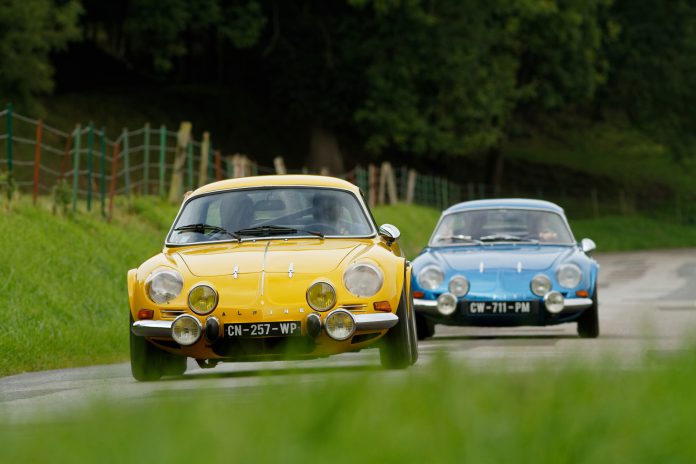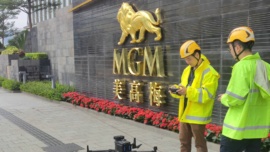By Guilherme Marques
In a world where it is said that passion for cars as objects of pure pleasure fades at high speed, someone had the courage to bring back to life a brand of sports cars that exist for one reason and one reason only: to be driven.
The name of that make is Alpine, and was founded 63 years ago by Jean Rédélé. After leaving his native Dieppe to study in Paris, Rédélé returned home to open a concession that doubled as a logistical base for the various races in which he took part, at the wheel of the humble Renault 4 CV.
 A virtuoso behind the wheel, the Frenchman was victorious on several occasions in competitions as important as the Mille Miglia and the Critérium des Alpes – a rally whose name inspired the brand itself.
A virtuoso behind the wheel, the Frenchman was victorious on several occasions in competitions as important as the Mille Miglia and the Critérium des Alpes – a rally whose name inspired the brand itself.
 The story of the French emblem began with the A106 model in 1955, a design based on the modest Renault 4 CV, followed by the A108 three years later, already built on a chassis developed for that effect. The A110 Berlinette, one of the most iconic cars in the entire history of automobiles and the model that put the brand on everyone’s lips, was launched in 1962 and quickly began wiping out the competition completely, with titles in France, Spain, Bulgaria and Romania. Jean Rédélé’s reputation as a creator of sports cars able to beat any adversary was further cemented with more competition wins, and reached its peak with the triumph at the Monte Carlo Rally of ’71, in which the brand saw its three cars get to the three first places. As if that weren’t enough, Rédélé’s creations repeated that achievement two years later, the year in which Alpine also picked up the World Constructors’ title in the World Rally Championship.
The story of the French emblem began with the A106 model in 1955, a design based on the modest Renault 4 CV, followed by the A108 three years later, already built on a chassis developed for that effect. The A110 Berlinette, one of the most iconic cars in the entire history of automobiles and the model that put the brand on everyone’s lips, was launched in 1962 and quickly began wiping out the competition completely, with titles in France, Spain, Bulgaria and Romania. Jean Rédélé’s reputation as a creator of sports cars able to beat any adversary was further cemented with more competition wins, and reached its peak with the triumph at the Monte Carlo Rally of ’71, in which the brand saw its three cars get to the three first places. As if that weren’t enough, Rédélé’s creations repeated that achievement two years later, the year in which Alpine also picked up the World Constructors’ title in the World Rally Championship.

 In 1975, the Renault Group acquired the Alpine brand, and the ever-closer collaboration between the two manufacturers resulted in a historical victory at the 24 Hours of Le Mans in 1978. The A442B, driven by Didier Pironi and Jean-Pierre Jaussaud, won the legendary resistance race with 369 laps on the Circuit de la Sarthe.
In 1975, the Renault Group acquired the Alpine brand, and the ever-closer collaboration between the two manufacturers resulted in a historical victory at the 24 Hours of Le Mans in 1978. The A442B, driven by Didier Pironi and Jean-Pierre Jaussaud, won the legendary resistance race with 369 laps on the Circuit de la Sarthe.
In 1995, Renault decided to suspend Alpine. For four decades, more than 30,000 units of various Alpine road models left the Dieppe factory, while more than 70 single-seaters and 37 sport-prototypes graced the most diverse competitions across the four corners of the globe. Overall, by 1995, Alpine had racked up over 1000 victories in its list of successes across all the disciplines of four-wheeled motorsports, along with 26 rally titles, six single-seater titles and four rallycross championships.
 It took 17 years for the Alpine name to appear once again in a press release from the Renault Group. In 2012, the French giant announced that it would revive the name founded by Jean Rédélé in a project that would follow the structural principles that had always defined the brand. Six years later, the new A110 is a reality and promises to win over a new generation of followers.
It took 17 years for the Alpine name to appear once again in a press release from the Renault Group. In 2012, the French giant announced that it would revive the name founded by Jean Rédélé in a project that would follow the structural principles that had always defined the brand. Six years later, the new A110 is a reality and promises to win over a new generation of followers.
With a chassis made entirely of aluminium so as to reduce the weight as much as possible, the first example of the 21st-century Alpine has a rear mid-engine with 1800cc and 252 horsepower, paired to a seven-speed automatic transmission controlled by paddle shifters placed on the steering wheel, which transfers the power exclusively to the rear wheels, in keeping with the tradition of the most prestigious sports cars in history and of all the Alpines that Jean Rédélé built in Dieppe. The historical factory is not only the spiritual headquarters of the brand, but it underwent a complete renovation to receive the production of the new A110, which won’t surpass 10,000 units per year, so that the standard of finishing, construction and quality stay true to the brand’s premium positioning in this new and exciting rebirth.
 Its light weight is also responsible for the A110’s extraordinary performances: 0-100km/h in just 4.5 seconds. The A110 preserves the aesthetic elegance of the 1962 original, introducing innovative and very modern solutions that make it instantly timeless. In fact, its inspiration from the A110 Berlinette is the most interesting way that the brand could have found to bridge the past and the future, and to captivate not only those who have never forgotten the significance of Alpine, but also those who were born while the brand was sleeping.
Its light weight is also responsible for the A110’s extraordinary performances: 0-100km/h in just 4.5 seconds. The A110 preserves the aesthetic elegance of the 1962 original, introducing innovative and very modern solutions that make it instantly timeless. In fact, its inspiration from the A110 Berlinette is the most interesting way that the brand could have found to bridge the past and the future, and to captivate not only those who have never forgotten the significance of Alpine, but also those who were born while the brand was sleeping.
 Inside, the avant-garde cabin marked by high-quality materials features the fabulous Sabelt sports seats, the Focal audio system and the floating centre console, which lends it an extremely attractive and decidedly different environment to that of the German competition.
Inside, the avant-garde cabin marked by high-quality materials features the fabulous Sabelt sports seats, the Focal audio system and the floating centre console, which lends it an extremely attractive and decidedly different environment to that of the German competition.
 On the track or on the road, one thing is certain: the Alpine is back, and that is great news for those who still love cars as machines of pleasure and liberation, creators of unforgettable movements that will forever be etched in the memory of those who experience them.
On the track or on the road, one thing is certain: the Alpine is back, and that is great news for those who still love cars as machines of pleasure and liberation, creators of unforgettable movements that will forever be etched in the memory of those who experience them.
























